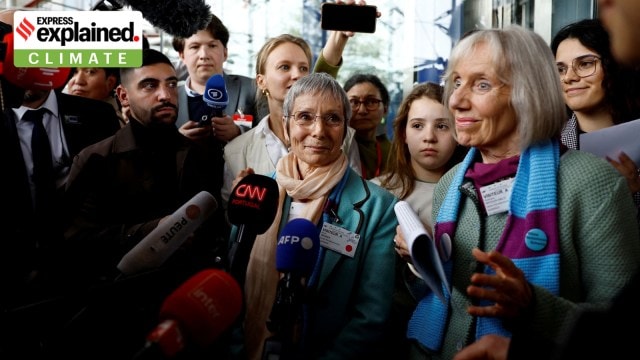Swiss women win landmark climate change case: Why is it significant?
The landmark ruling by the European Court of Human Rights (ECHR) could influence how courts across Europe and beyond deal with the cases in which petitioners argue that climate change involves human rights violations.
 Anne Mahrer and Rosmarie Wyder-Walti, of the Swiss elderly women group Senior Women for Climate Protection, talk to journalists after the verdict of the court in the climate case Verein KlimaSeniorinnen Schweiz and Others v. Switzerland, at the European Court of Human Rights (ECHR) in Strasbourg, France April 9, 2024. REUTERS/Christian Hartmann
Anne Mahrer and Rosmarie Wyder-Walti, of the Swiss elderly women group Senior Women for Climate Protection, talk to journalists after the verdict of the court in the climate case Verein KlimaSeniorinnen Schweiz and Others v. Switzerland, at the European Court of Human Rights (ECHR) in Strasbourg, France April 9, 2024. REUTERS/Christian HartmannOn Tuesday (April 9), Europe’s highest human rights court sided with a group of 2,000 Swiss women — all over the age of 64 — who had sued their government for violating their human rights by failing to do enough to combat the adverse effects of climate change.
The landmark ruling by the European Court of Human Rights (ECHR) could influence how courts across Europe and beyond deal with the cases in which petitioners argue that climate change involves human rights violations. It could also embolden more communities to sue their governments for not taking adequate steps to mitigate the effects of climate change.
Notably, the verdict has come just days after the Supreme Court of India expanded the scope of Articles 14 (right to equality) and 21 (protection of life and personal liberty), saying people have a “right to be free from the adverse effects of climate change”.
Here is a look at the case brought by the Swiss women, what the court said, why it is significant, and the rise of global climate litigation.
What was the case?
The case was brought against Switzerland by KlimaSeniorinnen Schweiz (Association of Senior Women for Climate Protection Switzerland), a group of women climate activists all above the age of 64, in November 2016. The women claimed that the Swiss government’s inadequate climate policies violate their right to life and other guarantees under the European Convention on Human Rights. The convention is an international agreement to protect human rights and political freedoms in Europe.
The petitioners built their case by partly relying on their medical vulnerability as senior citizens to extreme heat caused by climate change. They cited the reports by the Intergovernmental Panel on Climate Change (IPCC) — a United Nations body which assesses the science related to climate change.
The reports “show that the Swiss population of senior women — especially those over 75 — are more prone to heat-related medical problems like ‘dehydration, hyperthermia, fatigue, loss of consciousness, heat cramps and heat strokes,’” according to a report by Vox. As a result, the case was filed only by senior women, although they acknowledged that older men, people with diseases, and small children also suffer from heat waves and other climate effects.
What did the court say?
The ECHR noted that Article 8 of the convention, “encompasses a right for individuals to effective protection by the state authorities from the serious adverse effects of climate change on their lives, health, well-being and quality of life.”
The Swiss government, however, violated the law as it not only did not enact adequate laws to combat climate change impacts but also failed to meet greenhouse gas (GHG) emission goals, according to the court.
In her ruling, Court President Siofra O’Leary said: “It is clear that future generations are likely to bear an increasingly severe burden of the consequences of present failures and omissions to combat climate change”.
Why is the ruling significant?
The Swiss government is now obliged to update its climate change policies but the ECHR cannot tell authorities what kind of policies to implement.
Michael Burger, executive director of the Sabin Center for Climate Change Law at Columbia University, told Vox: “It (the ruling) doesn’t provide a specific injunction or any specific direction — it just says that you have to be more consistent with what the climate science says”.
Nonetheless, the judgment could have far-reaching implications. The ECHR’s verdict is applicable in 46 member states, including all the European Union (EU), plus the United Kingdom (UK) and various other non-EU countries. This means that any climate and human rights case brought before a judge in Europe’s national courts will now have to consider ECHR’s judgment in whatever decision they make. It may also encourage citizens and communities to file similar cases in countries that are party to the European Convention on Human Rights.
“The decision affirms that European Human Rights law… requires governments to pursue a high level of climate ambition,” Burger said.
The verdict could also influence other pending climate change cases before the ECHR. There are six such cases, including a lawsuit against the Norwegian government that has accused it of violating human rights by granting new licences for oil and gas exploration in the Barents Sea beyond 2035.
How has there been a rise in climate litigation across the globe?
The case brought against the Swiss government is emblematic of the recent rising tide of climate litigation — a form of legal action that is being used to hold countries and companies accountable for their climate mitigation efforts and historical contributions to climate change.
As of December 2022, there have been 2,180 climate-related cases filed in 65 jurisdictions, including international and regional courts, tribunals, quasi-judicial bodies, or other adjudicatory bodies across the world, according to the Global Climate Litigation Report: 2023 Status Review. This is a steady increase from 884 cases in 2017 and 1,550 cases in 2020.
“Children and youth, women’s groups, local communities, and Indigenous Peoples, among others, are taking a prominent role in bringing these cases and driving climate change governance reform in more and more countries around the world,” the report said.
Most recently, in August 2023, young plaintiffs of Montana, US, won a case against their state government in which the latter was found guilty of violating the plaintiffs’ constitutional right to a clean and healthful environment. The court said Montana’s neglect of climate change while approving fossil fuel projects was unconstitutional.
Similar cases have been filed in India also. In 2017, a 9-year-old girl from Uttarakhand approached the National Green Tribunal of India, arguing that the Public Trust Doctrine, India’s commitments under the Paris Agreement, and India’s existing environmental laws and climate-related policies oblige greater action to mitigate climate change. Her petition, however, was later rejected.
- 01
- 02
- 03
- 04
- 05







































